ECU HONDA CR-V 2016 RM1, RM3, RM4 / 4.G Quick Guide
[x] Cancel search | Manufacturer: HONDA, Model Year: 2016, Model line: CR-V, Model: HONDA CR-V 2016 RM1, RM3, RM4 / 4.GPages: 80, PDF Size: 7.99 MB
Page 5 of 80
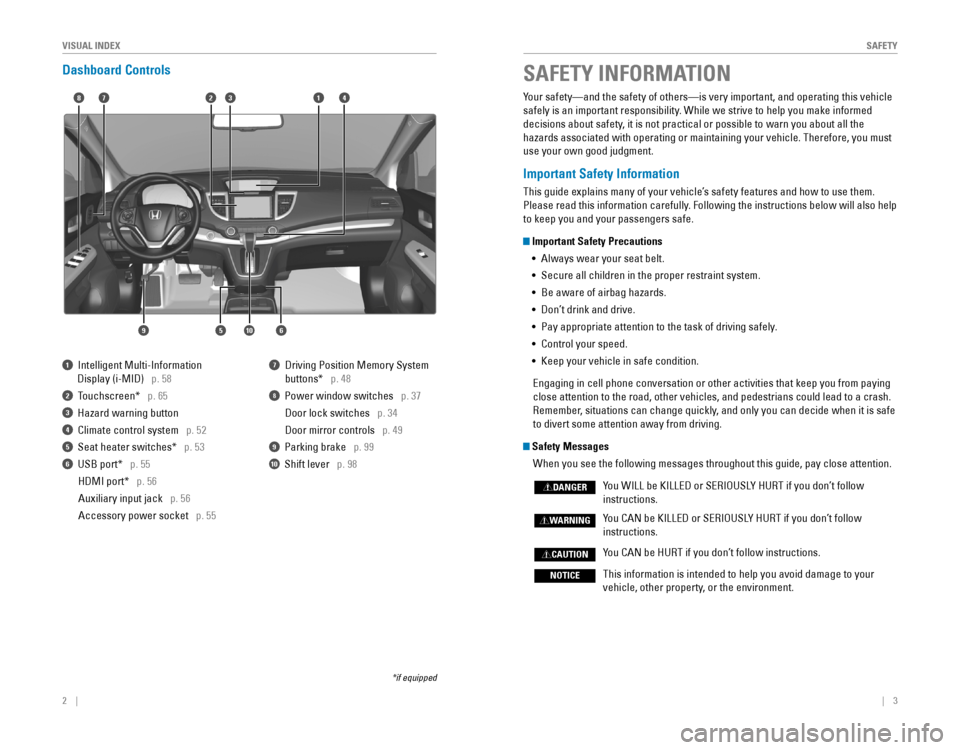
2 || 3
S
AFETYVISUAL INDEX
Dashboard Controls
1‚Äā‚ÄāIntelligent‚ÄāMulti-Information‚Äā
Display‚Äā(i-MID)‚Äā‚Äā‚Äāp. 58
2‚Äā‚ÄāTouchscreen*‚Äā‚Äā‚Äāp. 65
3‚Äā‚ÄāHazard‚Äāwarning‚Äābutton‚Äā
4 Climate control system p. 52
5‚Äā‚ÄāSeat‚Äāheater‚Äāswitches*‚Äā‚Äā‚Äāp. 53
6‚Äā‚ÄāUSB‚Äāport*‚Äā‚Äā‚Äāp. 55
‚ÄāHDMI‚Äāport*‚Äā‚Äā‚Äāp. 56
Auxiliary input jack p. 56
Accessory power socket p. 55
7‚ÄāDriving‚ÄāPosition‚ÄāMemory‚ÄāSystem‚Äā‚Äā ‚Äā
‚Äābuttons*‚Äā‚Äā‚Äāp.‚Äā48
8 Power window switches p.‚Äā37
‚ÄāDoor‚Äālock‚Äāswitches‚Äā‚Äā‚Äāp.‚Äā34
‚Äā‚Äā‚ÄāDoor‚Äāmirror‚Äācontrols‚Äā‚Äā‚Äāp.‚Äā49
9‚Äā‚ÄāParking‚Äābrake‚Äā‚Äā‚Äāp. 99
10 Shift lever p. 98
*if‚Äāequipped
Your safety‚ÄĒand the safety of others‚ÄĒis very important, and operati\
ng this vehicle
safely‚Äāis‚Äāan‚Äāimportant‚Äāresponsibility.‚ÄāWhile‚Äāwe‚Äāstrive‚Äāto‚Äāhelp‚Äāyou‚Äāmake‚Äāinformed‚Äā
decisions‚Äāabout‚Äāsafety,‚Äāit‚Äāis‚Äānot‚Äāpractical‚Äāor‚Äāpossible‚Äāto‚Äāwarn‚Äāyou‚Äāabout‚Äāall‚Äāthe‚Äā
hazards‚Äāassociated‚Äāwith‚Äāoperating‚Äāor‚Äāmaintaining‚Äāyour‚Äāvehicle.‚ÄāTherefore,‚Äāyou‚Äāmust‚Äā
use your own good judgment.
Important Safety Information
This guide explains many of your vehicle’s safety features and how to use them.
Please‚Äāread‚Äāthis‚Äāinformation‚Äācarefully.‚ÄāFollowing‚Äāthe‚Äāinstructions‚Äābelow‚Äāwill‚Äāalso‚Äāhelp‚Äā
to keep you and your passengers safe.
Important Safety Precautions ‚ÄĘ‚Äā
Always‚Äāwear‚Äāyour‚Äāseat‚Äābelt.
‚ÄĘ‚Äā Secure all children in the proper restraint system.
‚ÄĘ‚Äā
Be‚Äāaware‚Äāof‚Äāairbag‚Äāhazards.
‚ÄĘ‚ÄāDon‚Äôt‚Äādrink‚Äāand‚Äādrive.
‚ÄĘ‚Äā Pay appropriate attention to the task of driving safely.
‚ÄĘ‚Äā Control your speed.
‚ÄĘ‚Äā Keep your vehicle in safe condition.
Engaging‚Äāin‚Äācell‚Äāphone‚Äāconversation‚Äāor‚Äāother‚Äāactivities‚Äāthat‚Äākeep‚Äāyou‚Äāfrom‚Äāpaying‚Äā
close attention to the road, other vehicles, and pedestrians could lead \
to a crash.
Remember,‚Äāsituations‚Äācan‚Äāchange‚Äāquickly,‚Äāand‚Äāonly‚Äāyou‚Äācan‚Äādecide‚Äāwhen‚Äāit‚Äāis‚Äāsafe‚Äā
to divert some attention away from driving.
Safety Messages
When you see the following messages throughout this guide, pay close att\
ention.
You‚ÄāWILL‚Äābe‚ÄāKILLED‚Äāor‚ÄāSERIOUSLY‚ÄāHURT‚Äāif‚Äāyou‚Äādon‚Äôt‚Äāfollow‚Äā‚Äā‚Äā‚Äā
instructions.
You‚ÄāCAN‚Äābe‚ÄāKILLED‚Äāor‚ÄāSERIOUSLY‚ÄāHURT‚Äāif‚Äāyou‚Äādon‚Äôt‚Äāfollow‚Äā‚Äā ‚Äā
instructions.
You‚ÄāCAN‚Äābe‚ÄāHURT‚Äāif‚Äāyou‚Äādon‚Äôt‚Äāfollow‚Äāinstructions.
This information is intended to help you avoid damage to your
vehicle, other property, or the environment.
DANGER
WARNING
CAUTION
NOTICE
SAFETY INFORMATION
18
56
4732
910
Page 7 of 80
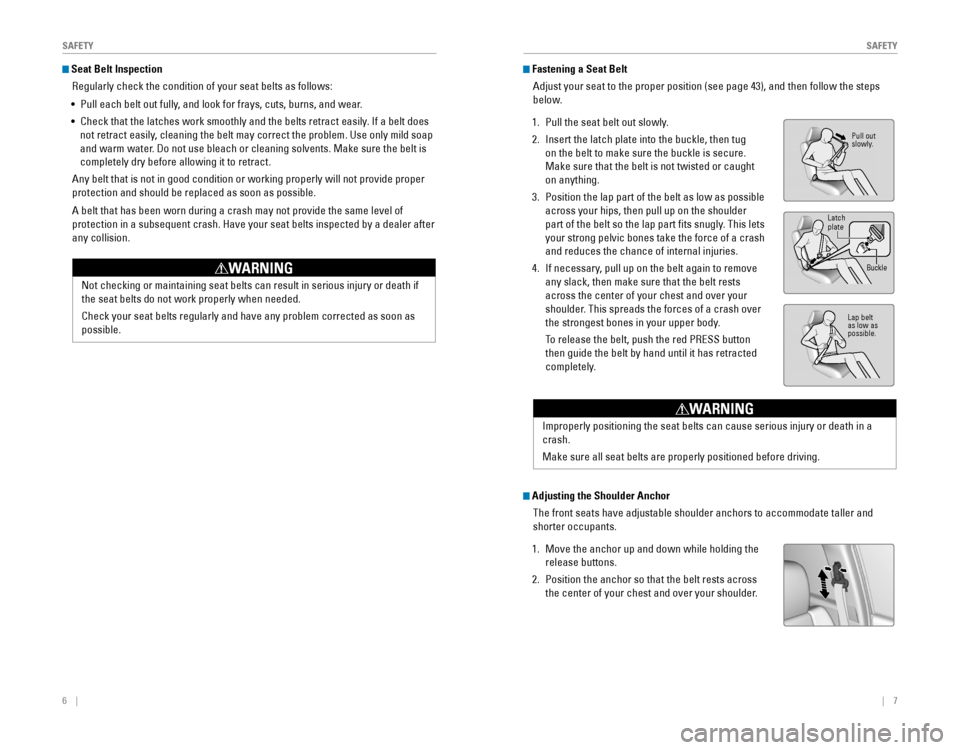
6 ||‚Äā‚Äā‚Äā‚Äā7
S
AFETYSAFETY
Seat Belt Inspection
Regularly‚Äācheck‚Äāthe‚Äācondition‚Äāof‚Äāyour‚Äāseat‚Äābelts‚Äāas‚Äāfollows:‚Äā
‚ÄĘ‚ÄāPull‚Äāeach‚Äābelt‚Äāout‚Äāfully,‚Äāand‚Äālook‚Äāfor‚Äāfrays,‚Äācuts,‚Äāburns,‚Äāand‚Äāwear.
‚ÄĘ‚ÄāCheck‚Äāthat‚Äāthe‚Äālatches‚Äāwork‚Äāsmoothly‚Äāand‚Äāthe‚Äābelts‚Äāretract‚Äāeasily.‚ÄāIf‚Äāa‚Äābelt‚Äādoes‚Äā
not‚Äāretract‚Äāeasily,‚Äācleaning‚Äāthe‚Äābelt‚Äāmay‚Äācorrect‚Äāthe‚Äāproblem.‚ÄāUse‚Äāonly‚Äāmild‚Äāsoap‚Äā
and‚Äāwarm‚Äāwater.‚ÄāDo‚Äānot‚Äāuse‚Äābleach‚Äāor‚Äācleaning‚Äāsolvents.‚ÄāMake‚Äāsure‚Äāthe‚Äābelt‚Äāis‚Äā
completely‚Äādry‚Äābefore‚Äāallowing‚Äāit‚Äāto‚Äāretract.
Any‚Äābelt‚Äāthat‚Äāis‚Äānot‚Äāin‚Äāgood‚Äācondition‚Äāor‚Äāworking‚Äāproperly‚Äāwill‚Äānot‚Äāprovide‚Äāproper‚Äā
protection‚Äāand‚Äāshould‚Äābe‚Äāreplaced‚Äāas‚Äāsoon‚Äāas‚Äāpossible.
A‚Äābelt‚Äāthat‚Äāhas‚Äābeen‚Äāworn‚Äāduring‚Äāa‚Äācrash‚Äāmay‚Äānot‚Äāprovide‚Äāthe‚Äāsame‚Äālevel‚Äāof‚Äā
protection‚Äāin‚Äāa‚Äāsubsequent‚Äācrash.‚ÄāHave‚Äāyour‚Äāseat‚Äābelts‚Äāinspected‚Äāby‚Äāa‚Äādealer‚Äāafter‚Äā
any collision.
Fastening a Seat Belt
Adjust‚Äāyour‚Äāseat‚Äāto‚Äāthe‚Äāproper‚Äāposition‚Äā(see‚Äāpage‚Äā43),‚Äāand‚Äāthen‚Äāfollow‚Äāthe‚Äāsteps‚Äā
below.
1. Pull‚Äāthe‚Äāseat‚Äābelt‚Äāout‚Äāslowly.
2. Insert‚Äāthe‚Äālatch‚Äāplate‚Äāinto‚Äāthe‚Äābuckle,‚Äāthen‚Äātug‚Äā
on‚Äāthe‚Äābelt‚Äāto‚Äāmake‚Äāsure‚Äāthe‚Äābuckle‚Äāis‚Äāsecure.‚Äā
Make‚Äāsure‚Äāthat‚Äāthe‚Äābelt‚Äāis‚Äānot‚Äātwisted‚Äāor‚Äācaught‚Äā
on anything.
3. Position‚Äāthe‚Äālap‚Äāpart‚Äāof‚Äāthe‚Äābelt‚Äāas‚Äālow‚Äāas‚Äāpossible‚Äā
across your hips, then pull up on the shoulder
part‚Äāof‚Äāthe‚Äābelt‚Äāso‚Äāthe‚Äālap‚Äāpart‚Äāfits‚Äāsnugly.‚ÄāThis‚Äālets‚Äā
your‚Äāstrong‚Äāpelvic‚Äābones‚Äātake‚Äāthe‚Äāforce‚Äāof‚Äāa‚Äācrash‚Äā
and reduces the chance of internal injuries.
4.‚ÄāIf‚Äānecessary,‚Äāpull‚Äāup‚Äāon‚Äāthe‚Äābelt‚Äāagain‚Äāto‚Äāremove‚Äā
any‚Äāslack,‚Äāthen‚Äāmake‚Äāsure‚Äāthat‚Äāthe‚Äābelt‚Äārests‚Äā
across the center of your chest and over your
shoulder. This spreads the forces of a crash over
the‚Äāstrongest‚Äābones‚Äāin‚Äāyour‚Äāupper‚Äābody.
‚ÄāTo‚Äārelease‚Äāthe‚Äābelt,‚Äāpush‚Äāthe‚Äāred‚ÄāPRESS‚Äābutton‚Äā
then‚Äāguide‚Äāthe‚Äābelt‚Äāby‚Äāhand‚Äāuntil‚Äāit‚Äāhas‚Äāretracted‚Äā
completely.
Not‚Äāchecking‚Äāor‚Äāmaintaining‚Äāseat‚Äābelts‚Äācan‚Äāresult‚Äāin‚Äāserious‚Äāinjury‚Äāor‚Äādeath‚Äāif‚Äā
the‚Äāseat‚Äābelts‚Äādo‚Äānot‚Äāwork‚Äāproperly‚Äāwhen‚Äāneeded.
Check‚Äāyour‚Äāseat‚Äābelts‚Äāregularly‚Äāand‚Äāhave‚Äāany‚Äāproblem‚Äācorrected‚Äāas‚Äāsoon‚Äāas‚Äā
possible.
WARNING
Pull out
slowly.
Lap‚Äābelt‚Äāas low as
possible.
Latch
plate
Buckle
Improperly‚Äāpositioning‚Äāthe‚Äāseat‚Äābelts‚Äācan‚Äācause‚Äāserious‚Äāinjury‚Äāor‚Äādeath‚Äāin‚Äāa‚Äā
crash.
Make‚Äāsure‚Äāall‚Äāseat‚Äābelts‚Äāare‚Äāproperly‚Äāpositioned‚Äābefore‚Äādriving.
WARNING
Adjusting the Shoulder Anchor
The‚Äāfront‚Äāseats‚Äāhave‚Äāadjustable‚Äāshoulder‚Äāanchors‚Äāto‚Äāaccommodate‚Äātaller‚Äāand‚Äā
shorter occupants.
1. Move the anchor up and down while holding the
release‚Äābuttons.
2. Position‚Äāthe‚Äāanchor‚Äāso‚Äāthat‚Äāthe‚Äābelt‚Äārests‚Äāacross‚Äā
the center of your chest and over your shoulder.
Page 11 of 80
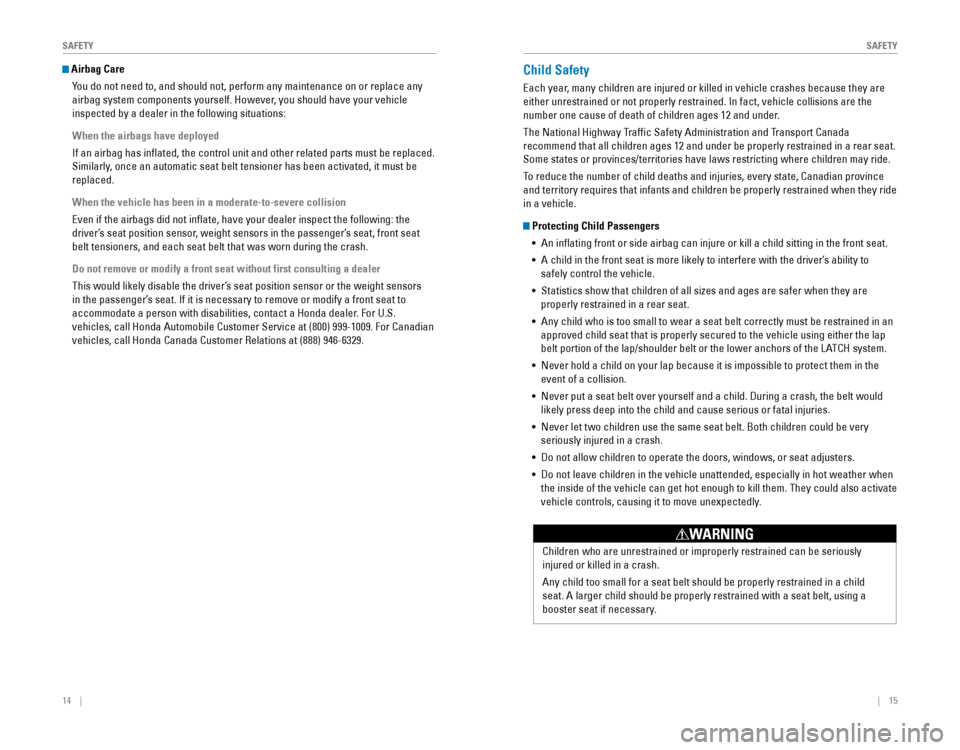
14‚Äā‚Äā‚Äā‚Äā|| 15
S
AFETYSAFETY
Airbag Care
You do not need to, and should not, perform any maintenance on or replace\
any
airbag‚Äāsystem‚Äācomponents‚Äāyourself.‚ÄāHowever,‚Äāyou‚Äāshould‚Äāhave‚Äāyour‚Äāvehicle‚Äā
inspected‚Äāby‚Äāa‚Äādealer‚Äāin‚Äāthe‚Äāfollowing‚Äāsituations:
When the airbags have deployed
If‚Äāan‚Äāairbag‚Äāhas‚Äāinflated,‚Äāthe‚Äācontrol‚Äāunit‚Äāand‚Äāother‚Äārelated‚Äāparts‚Äāmust‚Äābe‚Äāreplaced.‚Äā
Similarly,‚Äāonce‚Äāan‚Äāautomatic‚Äāseat‚Äābelt‚Äātensioner‚Äāhas‚Äābeen‚Äāactivated,‚Äāit‚Äāmust‚Äābe‚Äā
replaced.
When the vehicle has been in a moderate-to-severe collision
Even‚Äāif‚Äāthe‚Äāairbags‚Äādid‚Äānot‚Äāinflate,‚Äāhave‚Äāyour‚Äādealer‚Äāinspect‚Äāthe‚Äāfollowing:‚Äāthe‚Äā
driver’s seat position sensor, weight sensors in the passenger’s seat, front seat
belt‚Äātensioners,‚Äāand‚Äāeach‚Äāseat‚Äābelt‚Äāthat‚Äāwas‚Äāworn‚Äāduring‚Äāthe‚Äācrash.
Do not remove or modify a front seat without first consulting a dealer
This‚Äāwould‚Äālikely‚Äādisable‚Äāthe‚Äādriver‚Äôs‚Äāseat‚Äāposition‚Äāsensor‚Äāor‚Äāthe‚Äāweight‚Äāsensors‚Äā
in‚Äāthe‚Äāpassenger‚Äôs‚Äāseat.‚ÄāIf‚Äāit‚Äāis‚Äānecessary‚Äāto‚Äāremove‚Äāor‚Äāmodify‚Äāa‚Äāfront‚Äāseat‚Äāto‚Äā
accommodate‚Äāa‚Äāperson‚Äāwith‚Äādisabilities,‚Äācontact‚Äāa‚ÄāHonda‚Äādealer.‚ÄāFor‚ÄāU.S.‚Äā
vehicles,‚Äācall‚ÄāHonda‚ÄāAutomobile‚ÄāCustomer‚ÄāService‚Äāat‚Äā(800)‚Äā999-1009.‚ÄāFor‚ÄāCanadian‚Äā
vehicles,‚Äācall‚ÄāHonda‚ÄāCanada‚ÄāCustomer‚ÄāRelations‚Äāat‚Äā(888)‚Äā946-6329.
Child Safety
Each‚Äāyear,‚Äāmany‚Äāchildren‚Äāare‚Äāinjured‚Äāor‚Äākilled‚Äāin‚Äāvehicle‚Äācrashes‚Äābecause‚Äāthey‚Äāare‚Äā
either‚Äāunrestrained‚Äāor‚Äānot‚Äāproperly‚Äārestrained.‚ÄāIn‚Äāfact,‚Äāvehicle‚Äācollisions‚Äāare‚Äāthe‚Äā
number‚Äāone‚Äācause‚Äāof‚Äādeath‚Äāof‚Äāchildren‚Äāages‚Äā12‚Äāand‚Äāunder.
The National Highway Traffic Safety Administration and Transport Canada
recommend‚Äāthat‚Äāall‚Äāchildren‚Äāages‚Äā12‚Äāand‚Äāunder‚Äābe‚Äāproperly‚Äārestrained‚Äāin‚Äāa‚Äārear‚Äāseat.‚Äā
Some‚Äāstates‚Äāor‚Äāprovinces/territories‚Äāhave‚Äālaws‚Äārestricting‚Äāwhere‚Äāchildren‚Äāmay‚Äāride.‚Äā
To‚Äāreduce‚Äāthe‚Äānumber‚Äāof‚Äāchild‚Äādeaths‚Äāand‚Äāinjuries,‚Äāevery‚Äāstate,‚ÄāCanadian‚Äāprovince‚Äā
and‚Äāterritory‚Äārequires‚Äāthat‚Äāinfants‚Äāand‚Äāchildren‚Äābe‚Äāproperly‚Äārestrained‚Äāwhen‚Äāthey‚Äāride‚Äā
in a vehicle.
Protecting Child Passengers‚ÄĘ‚Äā
An‚Äāinflating‚Äāfront‚Äāor‚Äāside‚Äāairbag‚Äācan‚Äāinjure‚Äāor‚Äākill‚Äāa‚Äāchild‚Äāsitting‚Äāin‚Äāthe‚Äāfront‚Äāseat.
‚ÄĘ‚ÄāA‚Äāchild‚Äāin‚Äāthe‚Äāfront‚Äāseat‚Äāis‚Äāmore‚Äālikely‚Äāto‚Äāinterfere‚Äāwith‚Äāthe‚Äādriver‚Äôs‚Äāability‚Äāto‚Äā
safely control the vehicle.
‚ÄĘ‚Äā
Statistics‚Äāshow‚Äāthat‚Äāchildren‚Äāof‚Äāall‚Äāsizes‚Äāand‚Äāages‚Äāare‚Äāsafer‚Äāwhen‚Äāthey‚Äāare‚Äā
properly restrained in a rear seat.
‚ÄĘ‚Äā
Any‚Äāchild‚Äāwho‚Äāis‚Äātoo‚Äāsmall‚Äāto‚Äāwear‚Äāa‚Äāseat‚Äābelt‚Äācorrectly‚Äāmust‚Äābe‚Äārestrained‚Äāin‚Äāan‚Äā
approved child seat that is properly secured to the vehicle using either\
the lap
belt‚Äāportion‚Äāof‚Äāthe‚Äālap/shoulder‚Äābelt‚Äāor‚Äāthe‚Äālower‚Äāanchors‚Äāof‚Äāthe‚ÄāLATCH‚Äāsystem.
‚ÄĘ‚ÄāNever‚Äāhold‚Äāa‚Äāchild‚Äāon‚Äāyour‚Äālap‚Äābecause‚Äāit‚Äāis‚Äāimpossible‚Äāto‚Äāprotect‚Äāthem‚Äāin‚Äāthe‚Äā
event of a collision.
‚ÄĘ‚Äā
Never‚Äāput‚Äāa‚Äāseat‚Äābelt‚Äāover‚Äāyourself‚Äāand‚Äāa‚Äāchild.‚ÄāDuring‚Äāa‚Äācrash,‚Äāthe‚Äābelt‚Äāwould‚Äā
likely press deep into the child and cause serious or fatal injuries.
‚ÄĘ‚Äā
Never‚Äālet‚Äātwo‚Äāchildren‚Äāuse‚Äāthe‚Äāsame‚Äāseat‚Äābelt.‚ÄāBoth‚Äāchildren‚Äācould‚Äābe‚Äāvery‚Äā
seriously injured in a crash.
‚ÄĘ‚Äā
Do‚Äānot‚Äāallow‚Äāchildren‚Äāto‚Äāoperate‚Äāthe‚Äādoors,‚Äāwindows,‚Äāor‚Äāseat‚Äāadjusters.
‚ÄĘ‚ÄāDo‚Äānot‚Äāleave‚Äāchildren‚Äāin‚Äāthe‚Äāvehicle‚Äāunattended,‚Äāespecially‚Äāin‚Äāhot‚Äāweather‚Äāwhen‚Äā
the inside of the vehicle can get hot enough to kill them. They could al\
so activate
vehicle controls, causing it to move unexpectedly.
Children‚Äāwho‚Äāare‚Äāunrestrained‚Äāor‚Äāimproperly‚Äārestrained‚Äācan‚Äābe‚Äāseriously‚Äā
injured or killed in a crash.
Any‚Äāchild‚Äātoo‚Äāsmall‚Äāfor‚Äāa‚Äāseat‚Äābelt‚Äāshould‚Äābe‚Äāproperly‚Äārestrained‚Äāin‚Äāa‚Äāchild‚Äā
seat.‚ÄāA‚Äālarger‚Äāchild‚Äāshould‚Äābe‚Äāproperly‚Äārestrained‚Äāwith‚Äāa‚Äāseat‚Äābelt,‚Äāusing‚Äāa‚Äā
booster‚Äāseat‚Äāif‚Äānecessary.
WARNING
Page 12 of 80
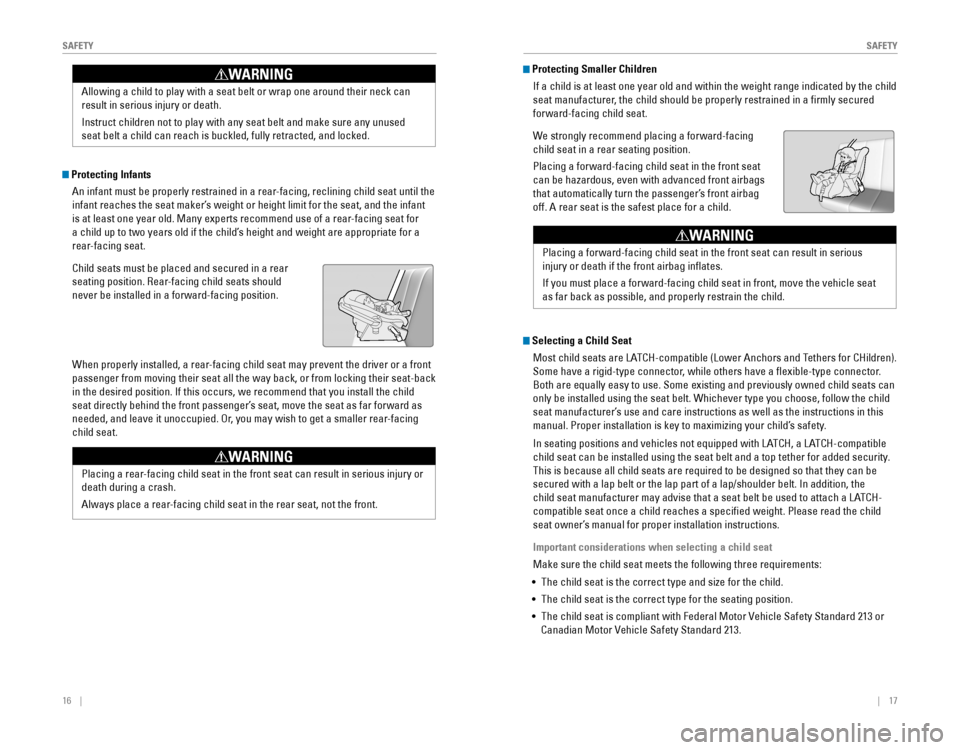
16 ||‚Äā‚Äā‚Äā‚Äā17
S
AFETYSAFETY
Protecting Infants
An‚Äāinfant‚Äāmust‚Äābe‚Äāproperly‚Äārestrained‚Äāin‚Äāa‚Äārear-facing,‚Äāreclining‚Äāchild‚Äāseat‚Äāuntil‚Äāthe‚Äā
infant reaches the seat maker’s weight or height limit for the seat, and the infant
is at least one year old. Many experts recommend use of a rear-facing seat for
a child up to two years old if the child’s height and weight are appropriate for a
rear-facing seat.
Child‚Äāseats‚Äāmust‚Äābe‚Äāplaced‚Äāand‚Äāsecured‚Äāin‚Äāa‚Äārear‚Äā
seating position. Rear-facing child seats should
never‚Äābe‚Äāinstalled‚Äāin‚Äāa‚Äāforward-facing‚Äāposition.
When properly installed, a rear-facing child seat may prevent the driver or a front
passenger‚Äāfrom‚Äāmoving‚Äātheir‚Äāseat‚Äāall‚Äāthe‚Äāway‚Äāback,‚Äāor‚Äāfrom‚Äālocking‚Äātheir‚Äāseat-back‚Äā
in‚Äāthe‚Äādesired‚Äāposition.‚ÄāIf‚Äāthis‚Äāoccurs,‚Äāwe‚Äārecommend‚Äāthat‚Äāyou‚Äāinstall‚Äāthe‚Äāchild‚Äā
seat‚Äādirectly‚Äābehind‚Äāthe‚Äāfront‚Äāpassenger‚Äôs‚Äāseat,‚Äāmove‚Äāthe‚Äāseat‚Äāas‚Äāfar‚Äāforward‚Äāas‚Äā
needed, and leave it unoccupied. Or, you may wish to get a smaller rear-facing
child seat.
Allowing‚Äāa‚Äāchild‚Äāto‚Äāplay‚Äāwith‚Äāa‚Äāseat‚Äābelt‚Äāor‚Äāwrap‚Äāone‚Äāaround‚Äātheir‚Äāneck‚Äācan‚Äā
result in serious injury or death.
Instruct‚Äāchildren‚Äānot‚Äāto‚Äāplay‚Äāwith‚Äāany‚Äāseat‚Äābelt‚Äāand‚Äāmake‚Äāsure‚Äāany‚Äāunused‚Äā
seat‚Äābelt‚Äāa‚Äāchild‚Äācan‚Äāreach‚Äāis‚Äābuckled,‚Äāfully‚Äāretracted,‚Äāand‚Äālocked.
WARNING Protecting Smaller Children
If‚Äāa‚Äāchild‚Äāis‚Äāat‚Äāleast‚Äāone‚Äāyear‚Äāold‚Äāand‚Äāwithin‚Äāthe‚Äāweight‚Äārange‚Äāindicated‚Äāby‚Äāthe‚Äāchild‚Äā
seat‚Äāmanufacturer,‚Äāthe‚Äāchild‚Äāshould‚Äābe‚Äāproperly‚Äārestrained‚Äāin‚Äāa‚Äāfirmly‚Äāsecured‚Äā
forward-facing child seat.
We strongly recommend placing a forward-facing
child seat in a rear seating position.
Placing a forward-facing child seat in the front seat
can‚Äābe‚Äāhazardous,‚Äāeven‚Äāwith‚Äāadvanced‚Äāfront‚Äāairbags‚Äā
that‚Äāautomatically‚Äāturn‚Äāthe‚Äāpassenger‚Äôs‚Äāfront‚Äāairbag‚Äā
off. A rear seat is the safest place for a child.
Selecting a Child Seat
Most‚Äāchild‚Äāseats‚Äāare‚ÄāLATCH-compatible‚Äā(Lower‚ÄāAnchors‚Äāand‚ÄāTethers‚Äāfor‚ÄāCHildren).‚Äā
Some‚Äāhave‚Äāa‚Äārigid-type‚Äāconnector,‚Äāwhile‚Äāothers‚Äāhave‚Äāa‚Äāflexible-type‚Äāconnector.‚Äā
Both‚Äāare‚Äāequally‚Äāeasy‚Äāto‚Äāuse.‚ÄāSome‚Äāexisting‚Äāand‚Äāpreviously‚Äāowned‚Äāchild‚Äāseats‚Äācan‚Äā
only‚Äābe‚Äāinstalled‚Äāusing‚Äāthe‚Äāseat‚Äābelt.‚ÄāWhichever‚Äātype‚Äāyou‚Äāchoose,‚Äāfollow‚Äāthe‚Äāchild‚Äā
seat manufacturer’s use and care instructions as well as the instructions in this
manual.‚ÄāProper‚Äāinstallation‚Äāis‚Äākey‚Äāto‚Äāmaximizing‚Äāyour‚Äāchild‚Äôs‚Äāsafety.
In‚Äāseating‚Äāpositions‚Äāand‚Äāvehicles‚Äānot‚Äāequipped‚Äāwith‚ÄāLATCH,‚Äāa‚ÄāLATCH-compatible‚Äā
child‚Äāseat‚Äācan‚Äābe‚Äāinstalled‚Äāusing‚Äāthe‚Äāseat‚Äābelt‚Äāand‚Äāa‚Äātop‚Äātether‚Äāfor‚Äāadded‚Äāsecurity.‚Äā
This‚Äāis‚Äābecause‚Äāall‚Äāchild‚Äāseats‚Äāare‚Äārequired‚Äāto‚Äābe‚Äādesigned‚Äāso‚Äāthat‚Äāthey‚Äācan‚Äābe‚Äā
secured‚Äāwith‚Äāa‚Äālap‚Äābelt‚Äāor‚Äāthe‚Äālap‚Äāpart‚Äāof‚Äāa‚Äālap/shoulder‚Äābelt.‚ÄāIn‚Äāaddition,‚Äāthe‚Äā
child‚Äāseat‚Äāmanufacturer‚Äāmay‚Äāadvise‚Äāthat‚Äāa‚Äāseat‚Äābelt‚Äābe‚Äāused‚Äāto‚Äāattach‚Äāa‚ÄāLATCH-
compatible‚Äāseat‚Äāonce‚Äāa‚Äāchild‚Äāreaches‚Äāa‚Äāspecified‚Äāweight.‚ÄāPlease‚Äāread‚Äāthe‚Äāchild‚Äā
seat owner’s manual for proper installation instructions.
Important considerations when selecting a child seat
Make‚Äāsure‚Äāthe‚Äāchild‚Äāseat‚Äāmeets‚Äāthe‚Äāfollowing‚Äāthree‚Äārequirements:
‚ÄĘ‚ÄāThe‚Äāchild‚Äāseat‚Äāis‚Äāthe‚Äācorrect‚Äātype‚Äāand‚Äāsize‚Äāfor‚Äāthe‚Äāchild.
‚ÄĘ‚Äā
The child seat is the correct type for the seating position.
‚ÄĘ‚Äā The child seat is compliant with Federal Motor Vehicle Safety Standard 213 or
Canadian Motor Vehicle Safety Standard 213.
Placing a rear-facing child seat in the front seat can result in serious injury or
death during a crash.
Always place a rear-facing child seat in the rear seat, not the front.
WARNING
Placing a forward-facing child seat in the front seat can result in seri\
ous
injury‚Äāor‚Äādeath‚Äāif‚Äāthe‚Äāfront‚Äāairbag‚Äāinflates.
If‚Äāyou‚Äāmust‚Äāplace‚Äāa‚Äāforward-facing‚Äāchild‚Äāseat‚Äāin‚Äāfront,‚Äāmove‚Äāthe‚Äāvehicle‚Äāseat‚Äā
as‚Äāfar‚Äāback‚Äāas‚Äāpossible,‚Äāand‚Äāproperly‚Äārestrain‚Äāthe‚Äāchild.
WARNING
Page 13 of 80
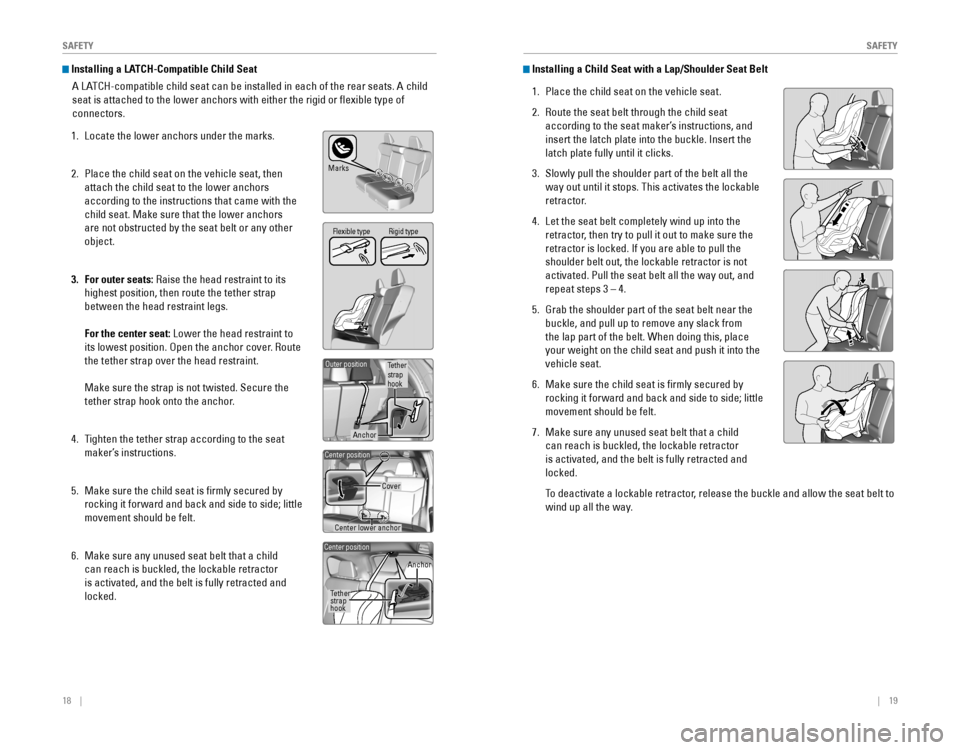
18 || 19
S
AFETYSAFETY
Installing a LATCH-Compatible Child Seat
A‚ÄāLATCH-compatible‚Äāchild‚Äāseat‚Äācan‚Äābe‚Äāinstalled‚Äāin‚Äāeach‚Äāof‚Äāthe‚Äārear‚Äāseats.‚ÄāA‚Äāchild‚Äā
seat‚Äāis‚Äāattached‚Äāto‚Äāthe‚Äālower‚Äāanchors‚Äāwith‚Äāeither‚Äāthe‚Äārigid‚Äāor‚Äāflexible‚Äātype‚Äāof‚Äā
connectors.
1. Locate the lower anchors under the marks.
2. Place the child seat on the vehicle seat, then
attach the child seat to the lower anchors
according to the instructions that came with the
child seat. Make sure that the lower anchors
are‚Äānot‚Äāobstructed‚Äāby‚Äāthe‚Äāseat‚Äābelt‚Äāor‚Äāany‚Äāother‚Äā
object.
3. For outer seats: Raise the head restraint to its
highest position, then route the tether strap
between‚Äāthe‚Äāhead‚Äārestraint‚Äālegs.
For the center seat: Lower the head restraint to
its lowest position. Open the anchor cover. Route
the tether strap over the head restraint.
Make sure the strap is not twisted. Secure the
tether strap hook onto the anchor.
4.‚ÄāTighten the tether strap according to the seat
maker’s instructions.
5. Make‚Äāsure‚Äāthe‚Äāchild‚Äāseat‚Äāis‚Äāfirmly‚Äāsecured‚Äāby‚Äā
rocking‚Äāit‚Äāforward‚Äāand‚Äāback‚Äāand‚Äāside‚Äāto‚Äāside;‚Äālittle‚Äā
movement‚Äāshould‚Äābe‚Äāfelt.
6. Make‚Äāsure‚Äāany‚Äāunused‚Äāseat‚Äābelt‚Äāthat‚Äāa‚Äāchild‚Äā
can‚Äāreach‚Äāis‚Äābuckled,‚Äāthe‚Äālockable‚Äāretractor‚Äā
is‚Äāactivated,‚Äāand‚Äāthe‚Äābelt‚Äāis‚Äāfully‚Äāretracted‚Äāand‚Äā
locked.
Installing a Child Seat with a Lap/Shoulder Seat Belt
1. Place the child seat on the vehicle seat.
2. Route‚Äāthe‚Äāseat‚Äābelt‚Äāthrough‚Äāthe‚Äāchild‚Äāseat‚Äā
according to the seat maker’s instructions, and
insert‚Äāthe‚Äālatch‚Äāplate‚Äāinto‚Äāthe‚Äābuckle.‚ÄāInsert‚Äāthe‚Äā
latch plate fully until it clicks.
3. Slowly‚Äāpull‚Äāthe‚Äāshoulder‚Äāpart‚Äāof‚Äāthe‚Äābelt‚Äāall‚Äāthe‚Äā
way‚Äāout‚Äāuntil‚Äāit‚Äāstops.‚ÄāThis‚Äāactivates‚Äāthe‚Äālockable‚Äā
retractor.
4.‚ÄāLet‚Äāthe‚Äāseat‚Äābelt‚Äācompletely‚Äāwind‚Äāup‚Äāinto‚Äāthe‚Äā
retractor, then try to pull it out to make sure the
retractor‚Äāis‚Äālocked.‚ÄāIf‚Äāyou‚Äāare‚Äāable‚Äāto‚Äāpull‚Äāthe‚Äā
shoulder‚Äābelt‚Äāout,‚Äāthe‚Äālockable‚Äāretractor‚Äāis‚Äānot‚Äā
activated.‚ÄāPull‚Äāthe‚Äāseat‚Äābelt‚Äāall‚Äāthe‚Äāway‚Äāout,‚Äāand‚Äā
repeat‚Äāsteps‚Äā3‚Äā‚Äď‚Äā4.
5. Grab‚Äāthe‚Äāshoulder‚Äāpart‚Äāof‚Äāthe‚Äāseat‚Äābelt‚Äānear‚Äāthe‚Äā
buckle,‚Äāand‚Äāpull‚Äāup‚Äāto‚Äāremove‚Äāany‚Äāslack‚Äāfrom‚Äā
the‚Äālap‚Äāpart‚Äāof‚Äāthe‚Äābelt.‚ÄāWhen‚Äādoing‚Äāthis,‚Äāplace‚Äā
your weight on the child seat and push it into the
vehicle seat.
6. Make‚Äāsure‚Äāthe‚Äāchild‚Äāseat‚Äāis‚Äāfirmly‚Äāsecured‚Äāby‚Äā
rocking‚Äāit‚Äāforward‚Äāand‚Äāback‚Äāand‚Äāside‚Äāto‚Äāside;‚Äālittle‚Äā
movement‚Äāshould‚Äābe‚Äāfelt.
7.‚ÄāMake‚Äāsure‚Äāany‚Äāunused‚Äāseat‚Äābelt‚Äāthat‚Äāa‚Äāchild‚Äā
can‚Äāreach‚Äāis‚Äābuckled,‚Äāthe‚Äālockable‚Äāretractor‚Äā
is‚Äāactivated,‚Äāand‚Äāthe‚Äābelt‚Äāis‚Äāfully‚Äāretracted‚Äāand‚Äā
locked.
‚ÄāTo‚Äādeactivate‚Äāa‚Äālockable‚Äāretractor,‚Äārelease‚Äāthe‚Äābuckle‚Äāand‚Äāallow‚Äāthe‚Äāseat‚Äābelt‚Äāto‚Äā
wind up all the way.
Marks
Flexible‚ÄātypeRigid type
Anchor Tether
strap
hook
Outer position
Cover
Center lower anchor
Center position
Tether
strap
hook Anchor
Center position
Page 14 of 80
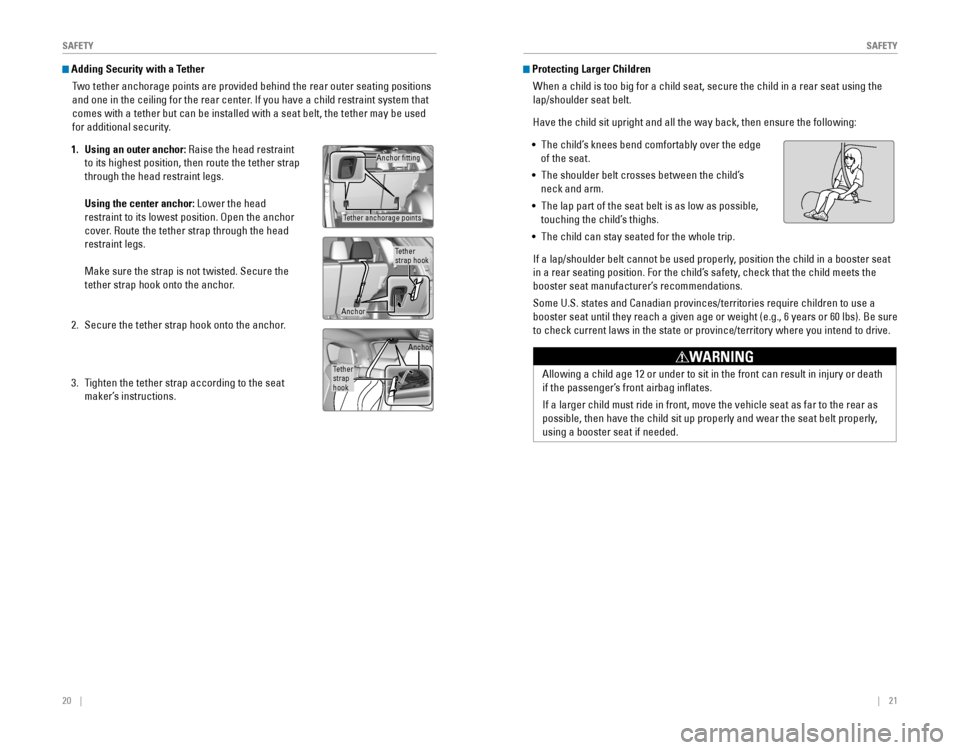
20 || 21
S
AFETYSAFETY
Adding Security with a Tether
Two‚Äātether‚Äāanchorage‚Äāpoints‚Äāare‚Äāprovided‚Äābehind‚Äāthe‚Äārear‚Äāouter‚Äāseating‚Äāpositions‚Äā
and‚Äāone‚Äāin‚Äāthe‚Äāceiling‚Äāfor‚Äāthe‚Äārear‚Äācenter.‚ÄāIf‚Äāyou‚Äāhave‚Äāa‚Äāchild‚Äārestraint‚Äāsystem‚Äāthat‚Äā
comes‚Äāwith‚Äāa‚Äātether‚Äābut‚Äācan‚Äābe‚Äāinstalled‚Äāwith‚Äāa‚Äāseat‚Äābelt,‚Äāthe‚Äātether‚Äāmay‚Äābe‚Äāused‚Äā
for additional security.
1. Using an outer anchor: Raise the head restraint
to its highest position, then route the tether strap
through the head restraint legs.
Using the center anchor: Lower the head
restraint to its lowest position. Open the anchor
cover. Route the tether strap through the head
restraint legs.
Make sure the strap is not twisted. Secure the
tether strap hook onto the anchor.
2. Secure the tether strap hook onto the anchor.
3. Tighten the tether strap according to the seat
maker’s instructions.
Protecting Larger Children
When‚Äāa‚Äāchild‚Äāis‚Äātoo‚Äābig‚Äāfor‚Äāa‚Äāchild‚Äāseat,‚Äāsecure‚Äāthe‚Äāchild‚Äāin‚Äāa‚Äārear‚Äāseat‚Äāusing‚Äāthe‚Äā
lap/shoulder‚Äāseat‚Äābelt.
Have‚Äāthe‚Äāchild‚Äāsit‚Äāupright‚Äāand‚Äāall‚Äāthe‚Äāway‚Äāback,‚Äāthen‚Äāensure‚Äāthe‚Äāfollowing:
‚ÄĘ‚ÄāThe‚Äāchild‚Äôs‚Äāknees‚Äābend‚Äācomfortably‚Äāover‚Äāthe‚Äāedge‚Äā
of the seat.
‚ÄĘ‚Äā
The‚Äāshoulder‚Äābelt‚Äācrosses‚Äābetween‚Äāthe‚Äāchild‚Äôs‚Äā
neck and arm.
‚ÄĘ‚Äā
The‚Äālap‚Äāpart‚Äāof‚Äāthe‚Äāseat‚Äābelt‚Äāis‚Äāas‚Äālow‚Äāas‚Äāpossible,‚Äā
touching the child’s thighs.
‚ÄĘ‚Äā The child can stay seated for the whole trip.
If‚Äāa‚Äālap/shoulder‚Äābelt‚Äācannot‚Äābe‚Äāused‚Äāproperly,‚Äāposition‚Äāthe‚Äāchild‚Äāin‚Äāa‚Äābooster‚Äāseat‚Äā
in a rear seating position. For the child’s safety, check that the child meets the
booster‚Äāseat‚Äāmanufacturer‚Äôs‚Äārecommendations.
Some‚ÄāU.S.‚Äāstates‚Äāand‚ÄāCanadian‚Äāprovinces/territories‚Äārequire‚Äāchildren‚Äāto‚Äāuse‚Äāa‚Äā
booster‚Äāseat‚Äāuntil‚Äāthey‚Äāreach‚Äāa‚Äāgiven‚Äāage‚Äāor‚Äāweight‚Äā(e.g.,‚Äā6‚Äāyears‚Äāor‚Äā60‚Äālbs).‚ÄāBe‚Äāsure‚Äā
to‚Äācheck‚Äācurrent‚Äālaws‚Äāin‚Äāthe‚Äāstate‚Äāor‚Äāprovince/territory‚Äāwhere‚Äāyou‚Äāintend‚Äāto‚Äādrive.
Tether anchorage points Anchor fitting
Anchor Tether
strap hook
Tether
strap
hook
AnchorAllowing a child age 12 or under to sit in the front can result in injur\
y or death
if‚Äāthe‚Äāpassenger‚Äôs‚Äāfront‚Äāairbag‚Äāinflates.
If‚Äāa‚Äālarger‚Äāchild‚Äāmust‚Äāride‚Äāin‚Äāfront,‚Äāmove‚Äāthe‚Äāvehicle‚Äāseat‚Äāas‚Äāfar‚Äāto‚Äāthe‚Äārear‚Äāas‚Äā
possible,‚Äāthen‚Äāhave‚Äāthe‚Äāchild‚Äāsit‚Äāup‚Äāproperly‚Äāand‚Äāwear‚Äāthe‚Äāseat‚Äābelt‚Äāproperly,‚Äā
using‚Äāa‚Äābooster‚Äāseat‚Äāif‚Äāneeded.
WARNING
Page 27 of 80
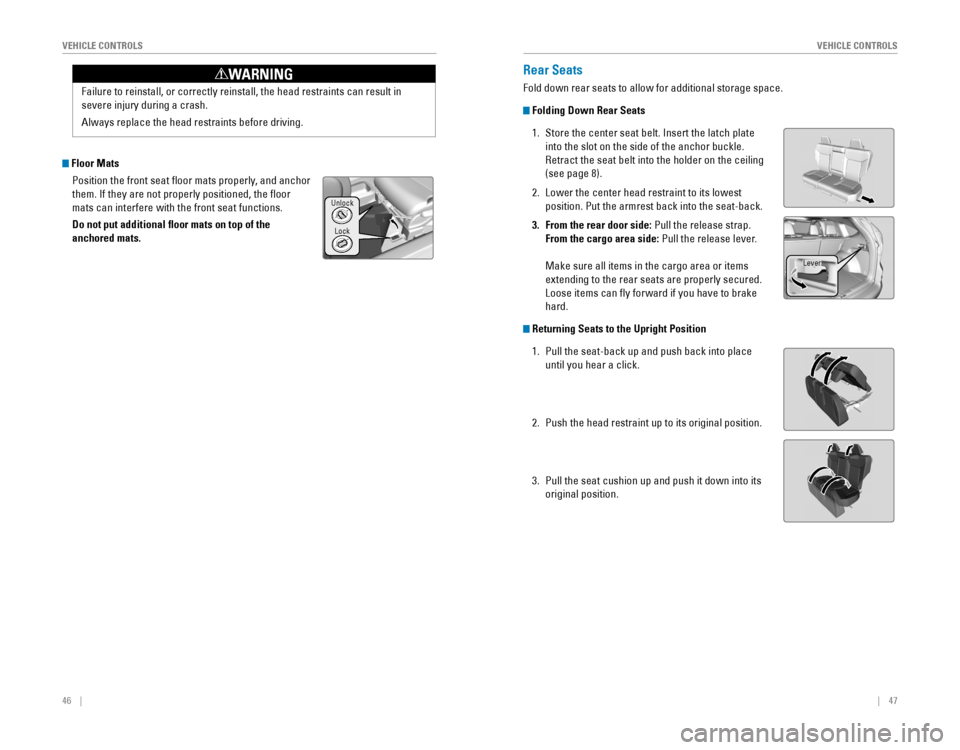
46‚Äā‚Äā‚Äā‚Äā||‚Äā‚Äā‚Äā‚Äā47
V
EHICLE CONTROLSVEHICLE CONTROLS
Failure to reinstall, or correctly reinstall, the head restraints can re\
sult in
severe injury during a crash.
Always‚Äāreplace‚Äāthe‚Äāhead‚Äārestraints‚Äābefore‚Äādriving.
WARNING
Floor Mats
Position the front seat floor mats properly, and anchor
them.‚ÄāIf‚Äāthey‚Äāare‚Äānot‚Äāproperly‚Äāpositioned,‚Äāthe‚Äāfloor‚Äā
mats can interfere with the front seat functions.
Do not put additional floor mats on top of the
anchored mats.Unlock
Lock
Rear Seats
Fold down rear seats to allow for additional storage space.
Folding Down Rear Seats
1. Store‚Äāthe‚Äācenter‚Äāseat‚Äābelt.‚ÄāInsert‚Äāthe‚Äālatch‚Äāplate‚Äā
into‚Äāthe‚Äāslot‚Äāon‚Äāthe‚Äāside‚Äāof‚Äāthe‚Äāanchor‚Äābuckle.‚Äā
Retract‚Äāthe‚Äāseat‚Äābelt‚Äāinto‚Äāthe‚Äāholder‚Äāon‚Äāthe‚Äāceiling‚Äā
(see page 8).
2. Lower the center head restraint to its lowest
position.‚ÄāPut‚Äāthe‚Äāarmrest‚Äāback‚Äāinto‚Äāthe‚Äāseat-back.
3. From the rear door side: Pull the release strap.
From the cargo area side: Pull the release lever.
Make sure all items in the cargo area or items
extending to the rear seats are properly secured.
Loose‚Äāitems‚Äācan‚Äāfly‚Äāforward‚Äāif‚Äāyou‚Äāhave‚Äāto‚Äābrake‚Äā
hard.
Returning Seats to the Upright Position
1. Pull‚Äāthe‚Äāseat-back‚Äāup‚Äāand‚Äāpush‚Äāback‚Äāinto‚Äāplace‚Äā
until you hear a click.
2. Push the head restraint up to its original position.
3. Pull the seat cushion up and push it down into its
original position.
Lever
Page 29 of 80
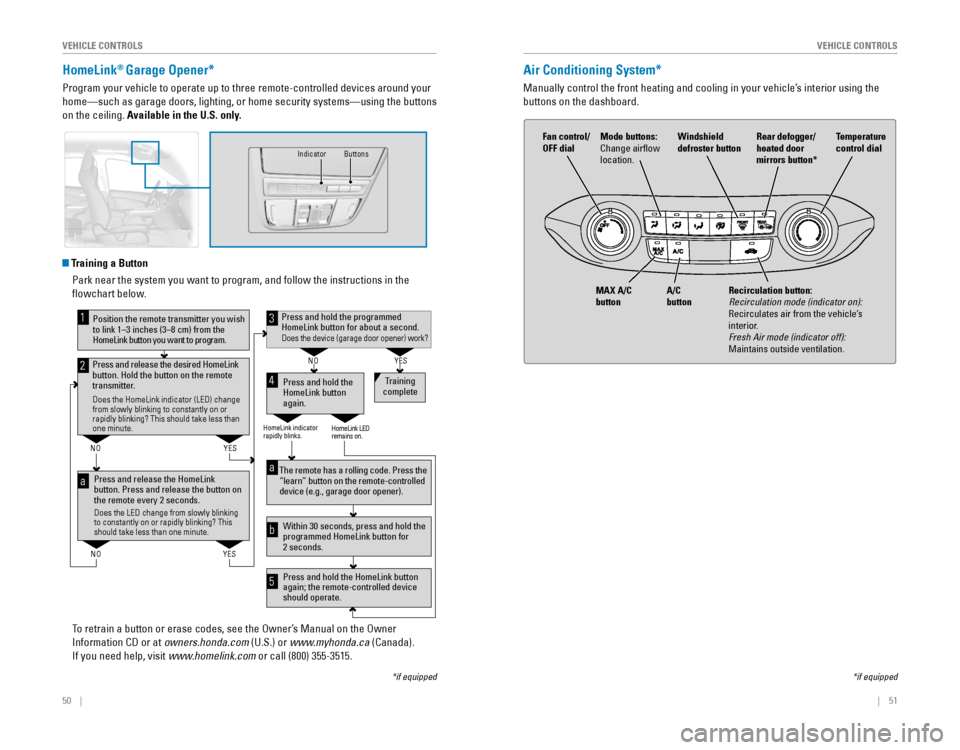
50 || 51
V
EHICLE CONTROLSVEHICLE CONTROLS
HomeLink¬ģ Garage Opener*
Program your vehicle to operate up to three remote-controlled devices ar\
ound your
home‚ÄĒsuch‚Äāas‚Äāgarage‚Äādoors,‚Äālighting,‚Äāor‚Äāhome‚Äāsecurity‚Äāsystems‚ÄĒusing‚Äāthe‚Äābuttons‚Äā
on the ceiling. Available in the U.S. only.
*if‚Äāequipped
Indicator
Buttons
Air Conditioning System*
Manually control the front heating and cooling in your vehicle’s interior using the
buttons‚Äāon‚Äāthe‚Äādashboard.
*if‚Äāequipped
Press and release the HomeLink
button. Press and release the button on
the remote every 2 seconds.
Does the LED change from slowly blinking
to constantly on or rapidly blinking? This
should take less than one minute.
Press and hold the
HomeLink button
again. Training
complete
YES
NO
HomeLink indicator
rapidly blinks. HomeLink LED
remains on.
YES
NO
YES
NO
Position the remote transmitter you wish
to link 1‚Äď3 inches (3‚Äď8 cm) from the
HomeLink button you want to program.1
Press and release the desired HomeLink
button. Hold the button on the remote
transmitter.
Does the HomeLink indicator (LED) change
from slowly blinking to constantly on or
rapidly blinking? This should take less than
one minute.
2
aThe remote has a rolling code. Press the
‚Äúlearn‚ÄĚ button on the remote-controlled
device (e.g., garage door opener) .
Press and hold the HomeLink button
again; the remote-controlled device
should operate. Within 30 seconds, press and hold the
programmed HomeLink button for
2 seconds.a
Press and hold the programmed
HomeLink button for about a second.
Does the device (garage door opener) work?
3
b
4
5
Training a Button Park near the system you want to program, and follow the instructions in\
the
flowchart‚Äābelow.
To‚Äāretrain‚Äāa‚Äābutton‚Äāor‚Äāerase‚Äācodes,‚Äāsee‚Äāthe‚ÄāOwner‚Äôs‚ÄāManual‚Äāon‚Äāthe‚ÄāOwner‚Äā
Information‚ÄāCD‚Äāor‚Äāat‚Äāowners.honda.com‚Äā(U.S.)‚Äāor‚Äāwww.myhonda.ca‚Äā(Canada).
If‚Äāyou‚Äāneed‚Äāhelp,‚Äāvisit‚Äāwww.homelink.com or call (800) 355-3515.
Fan control/
OFF dial
A/C
button
MAX A/C
button Windshield
defroster button
Temperature
control dial
Recirculation button:
Recirculation‚Äāmode‚Äā(indicator‚Äāon):
Recirculates air from the vehicle’s
interior.
Fresh‚ÄāAir‚Äāmode‚Äā(indicator‚Äāoff):
Maintains outside ventilation. Rear defogger/
heated door
mirrors button*
Mode buttons:
Change airflow
location.
Page 50 of 80
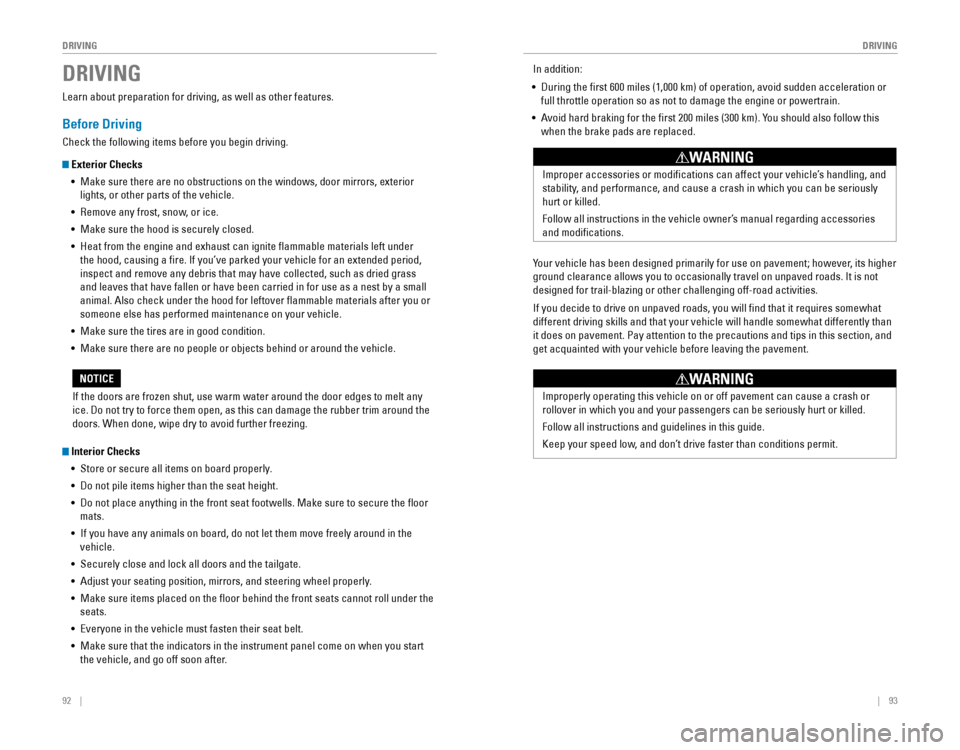
92 || 93
DRIVING
DRIVING
Learn‚Äāabout‚Äāpreparation‚Äāfor‚Äādriving,‚Äāas‚Äāwell‚Äāas‚Äāother‚Äāfeatures.
Before Driving
Check‚Äāthe‚Äāfollowing‚Äāitems‚Äābefore‚Äāyou‚Äābegin‚Äādriving.
Exterior Checks
‚ÄĘ‚Äā
Make‚Äāsure‚Äāthere‚Äāare‚Äāno‚Äāobstructions‚Äāon‚Äāthe‚Äāwindows,‚Äādoor‚Äāmirrors,‚Äāexterior‚Äā
lights, or other parts of the vehicle.
‚ÄĘ‚Äā Remove any frost, snow, or ice.
‚ÄĘ‚Äā Make sure the hood is securely closed.
‚ÄĘ‚Äā
Heat‚Äāfrom‚Äāthe‚Äāengine‚Äāand‚Äāexhaust‚Äācan‚Äāignite‚Äāflammable‚Äāmaterials‚Äāleft‚Äāunder‚Äā
the‚Äāhood,‚Äācausing‚Äāa‚Äāfire.‚ÄāIf‚Äāyou‚Äôve‚Äāparked‚Äāyour‚Äāvehicle‚Äāfor‚Äāan‚Äāextended‚Äāperiod,‚Äā
inspect‚Äāand‚Äāremove‚Äāany‚Äādebris‚Äāthat‚Äāmay‚Äāhave‚Äācollected,‚Äāsuch‚Äāas‚Äādried‚Äāgrass‚Äā
and‚Äāleaves‚Äāthat‚Äāhave‚Äāfallen‚Äāor‚Äāhave‚Äābeen‚Äācarried‚Äāin‚Äāfor‚Äāuse‚Äāas‚Äāa‚Äānest‚Äāby‚Äāa‚Äāsmall‚Äā
animal.‚ÄāAlso‚Äācheck‚Äāunder‚Äāthe‚Äāhood‚Äāfor‚Äāleftover‚Äāflammable‚Äāmaterials‚Äāafter‚Äāyou‚Äāor‚Äā
someone else has performed maintenance on your vehicle.
‚ÄĘ‚Äā Make sure the tires are in good condition.
‚ÄĘ‚Äā
Make‚Äāsure‚Äāthere‚Äāare‚Äāno‚Äāpeople‚Äāor‚Äāobjects‚Äābehind‚Äāor‚Äāaround‚Äāthe‚Äāvehicle.
DRIVING
If‚Äāthe‚Äādoors‚Äāare‚Äāfrozen‚Äāshut,‚Äāuse‚Äāwarm‚Äāwater‚Äāaround‚Äāthe‚Äādoor‚Äāedges‚Äāto‚Äāmelt‚Äāany‚Äā
ice.‚ÄāDo‚Äānot‚Äātry‚Äāto‚Äāforce‚Äāthem‚Äāopen,‚Äāas‚Äāthis‚Äācan‚Äādamage‚Äāthe‚Äārubber‚Äātrim‚Äāaround‚Äāthe‚Äā
doors.‚ÄāWhen‚Äādone,‚Äāwipe‚Äādry‚Äāto‚Äāavoid‚Äāfurther‚Äāfreezing.
NOTICE
Improper‚Äāaccessories‚Äāor‚Äāmodifications‚Äācan‚Äāaffect‚Äāyour‚Äāvehicle‚Äôs‚Äāhandling,‚Äāand‚Äā
stability,‚Äāand‚Äāperformance,‚Äāand‚Äācause‚Äāa‚Äācrash‚Äāin‚Äāwhich‚Äāyou‚Äācan‚Äābe‚Äāseriously‚Äā
hurt or killed.
Follow all instructions in the vehicle owner’s manual regarding accessories
and modifications.
WARNING
In‚Äāaddition:
‚ÄĘ‚ÄāDuring‚Äāthe‚Äāfirst‚Äā600‚Äāmiles‚Äā(1,000‚Äākm)‚Äāof‚Äāoperation,‚Äāavoid‚Äāsudden‚Äāacceleration‚Äāor‚Äā
full throttle operation so as not to damage the engine or powertrain.
‚ÄĘ‚Äā
Avoid‚Äāhard‚Äābraking‚Äāfor‚Äāthe‚Äāfirst‚Äā200‚Äāmiles‚Äā(300‚Äākm).‚ÄāYou‚Äāshould‚Äāalso‚Äāfollow‚Äāthis‚Äā
when‚Äāthe‚Äābrake‚Äāpads‚Äāare‚Äāreplaced.
Your‚Äāvehicle‚Äāhas‚Äābeen‚Äādesigned‚Äāprimarily‚Äāfor‚Äāuse‚Äāon‚Äāpavement;‚Äāhowever,‚Äāits‚Äāhigher‚Äā
ground‚Äāclearance‚Äāallows‚Äāyou‚Äāto‚Äāoccasionally‚Äātravel‚Äāon‚Äāunpaved‚Äāroads.‚ÄāIt‚Äāis‚Äānot‚Äā
designed‚Äāfor‚Äātrail-blazing‚Äāor‚Äāother‚Äāchallenging‚Äāoff-road‚Äāactivities.
If‚Äāyou‚Äādecide‚Äāto‚Äādrive‚Äāon‚Äāunpaved‚Äāroads,‚Äāyou‚Äāwill‚Äāfind‚Äāthat‚Äāit‚Äārequires‚Äāsomewhat‚Äā
different driving skills and that your vehicle will handle somewhat diff\
erently than
it does on pavement. Pay attention to the precautions and tips in this s\
ection, and
get‚Äāacquainted‚Äāwith‚Äāyour‚Äāvehicle‚Äābefore‚Äāleaving‚Äāthe‚Äāpavement.
Improperly‚Äāoperating‚Äāthis‚Äāvehicle‚Äāon‚Äāor‚Äāoff‚Äāpavement‚Äācan‚Äācause‚Äāa‚Äācrash‚Äāor‚Äā
rollover‚Äāin‚Äāwhich‚Äāyou‚Äāand‚Äāyour‚Äāpassengers‚Äācan‚Äābe‚Äāseriously‚Äāhurt‚Äāor‚Äākilled.
Follow all instructions and guidelines in this guide.
Keep your speed low, and don’t drive faster than conditions permit.
WARNING
Interior Checks ‚ÄĘ‚Äā
Store‚Äāor‚Äāsecure‚Äāall‚Äāitems‚Äāon‚Äāboard‚Äāproperly.
‚ÄĘ‚ÄāDo‚Äānot‚Äāpile‚Äāitems‚Äāhigher‚Äāthan‚Äāthe‚Äāseat‚Äāheight.
‚ÄĘ‚ÄāDo‚Äānot‚Äāplace‚Äāanything‚Äāin‚Äāthe‚Äāfront‚Äāseat‚Äāfootwells.‚ÄāMake‚Äāsure‚Äāto‚Äāsecure‚Äāthe‚Äāfloor‚Äā
mats.
‚ÄĘ‚Äā
If‚Äāyou‚Äāhave‚Äāany‚Äāanimals‚Äāon‚Äāboard,‚Äādo‚Äānot‚Äālet‚Äāthem‚Äāmove‚Äāfreely‚Äāaround‚Äāin‚Äāthe‚Äā
vehicle.
‚ÄĘ‚Äā Securely close and lock all doors and the tailgate.
‚ÄĘ‚Äā Adjust your seating position, mirrors, and steering wheel properly.
‚ÄĘ‚Äā
Make‚Äāsure‚Äāitems‚Äāplaced‚Äāon‚Äāthe‚Äāfloor‚Äābehind‚Äāthe‚Äāfront‚Äāseats‚Äācannot‚Äāroll‚Äāunder‚Äāthe‚Äā
seats.
‚ÄĘ‚Äā
Everyone‚Äāin‚Äāthe‚Äāvehicle‚Äāmust‚Äāfasten‚Äātheir‚Äāseat‚Äābelt.
‚ÄĘ‚Äā Make sure that the indicators in the instrument panel come on when you s\
tart
the vehicle, and go off soon after.
Page 52 of 80
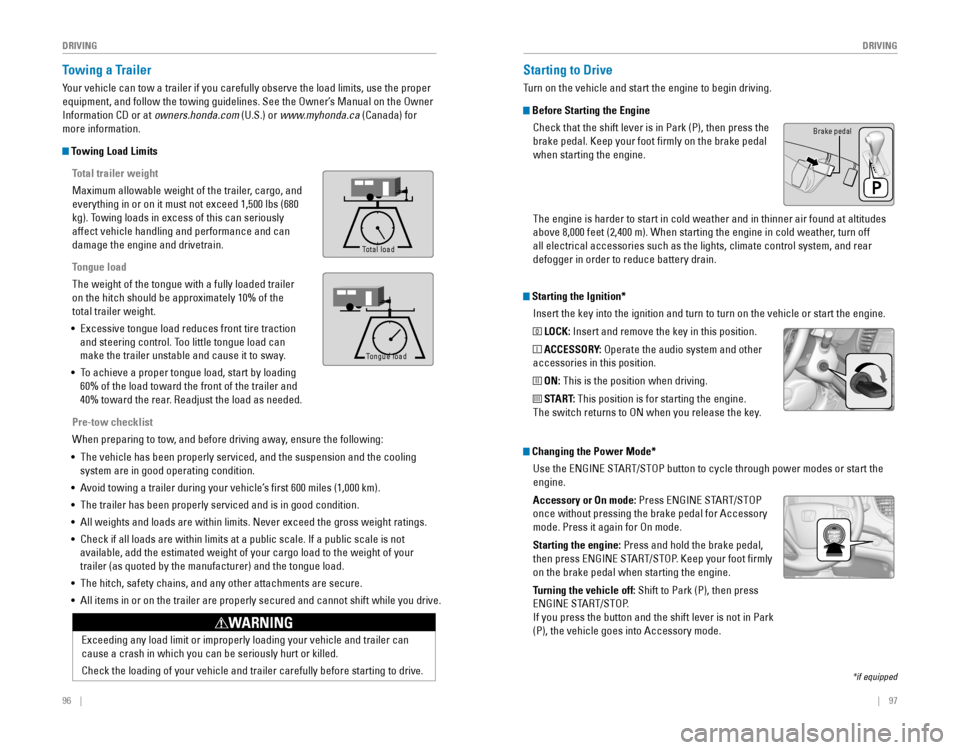
96 ||‚Äā‚Äā‚Äā‚Äā97
DRIVING
DRIVING
Exceeding‚Äāany‚Äāload‚Äālimit‚Äāor‚Äāimproperly‚Äāloading‚Äāyour‚Äāvehicle‚Äāand‚Äātrailer‚Äācan‚Äā
cause‚Äāa‚Äācrash‚Äāin‚Äāwhich‚Äāyou‚Äācan‚Äābe‚Äāseriously‚Äāhurt‚Äāor‚Äākilled.
Check‚Äāthe‚Äāloading‚Äāof‚Äāyour‚Äāvehicle‚Äāand‚Äātrailer‚Äācarefully‚Äābefore‚Äāstarting‚Äāto‚Äādrive.
WARNING
Towing a Trailer
Your‚Äāvehicle‚Äācan‚Äātow‚Äāa‚Äātrailer‚Äāif‚Äāyou‚Äācarefully‚Äāobserve‚Äāthe‚Äāload‚Äālimits,‚Äāuse‚Äāthe‚Äāproper‚Äā
equipment,‚Äāand‚Äāfollow‚Äāthe‚Äātowing‚Äāguidelines.‚ÄāSee‚Äāthe‚ÄāOwner‚Äôs‚ÄāManual‚Äāon‚Äāthe‚ÄāOwner‚Äā
Information‚ÄāCD‚Äāor‚Äāat‚Äāowners.honda.com (U.S.) or www.myhonda.ca (Canada) for
more information.
Towing Load Limits
Total trailer weight
Maximum‚Äāallowable‚Äāweight‚Äāof‚Äāthe‚Äātrailer,‚Äācargo,‚Äāand‚Äā
everything‚Äāin‚Äāor‚Äāon‚Äāit‚Äāmust‚Äānot‚Äāexceed‚Äā1,500‚Äālbs‚Äā(680‚Äā
kg). Towing loads in excess of this can seriously
affect vehicle handling and performance and can
damage the engine and drivetrain.
Tongue load
The weight of the tongue with a fully loaded trailer
on‚Äāthe‚Äāhitch‚Äāshould‚Äābe‚Äāapproximately‚Äā10%‚Äāof‚Äāthe‚Äā
total trailer weight.
‚ÄĘ‚Äā
Excessive‚Äātongue‚Äāload‚Äāreduces‚Äāfront‚Äātire‚Äātraction‚Äā
and steering control. Too little tongue load can
make‚Äāthe‚Äātrailer‚Äāunstable‚Äāand‚Äācause‚Äāit‚Äāto‚Äāsway.
‚ÄĘ‚ÄāTo‚Äāachieve‚Äāa‚Äāproper‚Äātongue‚Äāload,‚Äāstart‚Äāby‚Äāloading‚Äā
60%‚Äāof‚Äāthe‚Äāload‚Äātoward‚Äāthe‚Äāfront‚Äāof‚Äāthe‚Äātrailer‚Äāand‚Äā
40%‚Äātoward‚Äāthe‚Äārear.‚ÄāReadjust‚Äāthe‚Äāload‚Äāas‚Äāneeded.
Pre-tow checklist
When‚Äāpreparing‚Äāto‚Äātow,‚Äāand‚Äābefore‚Äādriving‚Äāaway,‚Äāensure‚Äāthe‚Äāfollowing:
‚ÄĘ‚ÄāThe‚Äāvehicle‚Äāhas‚Äābeen‚Äāproperly‚Äāserviced,‚Äāand‚Äāthe‚Äāsuspension‚Äāand‚Äāthe‚Äācooling‚Äā
system are in good operating condition.
‚ÄĘ‚Äā Avoid towing a trailer during your vehicle‚Äôs first 600 miles (1,000 km).
‚ÄĘ‚Äā
The‚Äātrailer‚Äāhas‚Äābeen‚Äāproperly‚Äāserviced‚Äāand‚Äāis‚Äāin‚Äāgood‚Äācondition.
‚ÄĘ‚Äā All weights and loads are within limits. Never exceed the gross weight r\
atings.
‚ÄĘ‚Äā
Check‚Äāif‚Äāall‚Äāloads‚Äāare‚Äāwithin‚Äālimits‚Äāat‚Äāa‚Äāpublic‚Äāscale.‚ÄāIf‚Äāa‚Äāpublic‚Äāscale‚Äāis‚Äānot‚Äā
available,‚Äāadd‚Äāthe‚Äāestimated‚Äāweight‚Äāof‚Äāyour‚Äācargo‚Äāload‚Äāto‚Äāthe‚Äāweight‚Äāof‚Äāyour‚Äā
trailer‚Äā(as‚Äāquoted‚Äāby‚Äāthe‚Äāmanufacturer)‚Äāand‚Äāthe‚Äātongue‚Äāload.
‚ÄĘ‚Äā The hitch, safety chains, and any other attachments are secure.
‚ÄĘ‚Äā All items in or on the trailer are properly secured and cannot shift whi\
le you drive.
To ng ue Loa d
Tong ue Loa d
Total load
Tongue load
Starting the Ignition*
Insert‚Äāthe‚Äākey‚Äāinto‚Äāthe‚Äāignition‚Äāand‚Äāturn‚Äāto‚Äāturn‚Äāon‚Äāthe‚Äāvehicle‚Äāor‚Äāstart‚Äāthe‚Äāengine.
0 LOCK: Insert‚Äāand‚Äāremove‚Äāthe‚Äākey‚Äāin‚Äāthis‚Äāposition.
I ACCESSORY: Operate the audio system and other
accessories in this position.
II ON: This is the position when driving.
III START: This position is for starting the engine.
The switch returns to ON when you release the key.
Starting to Drive
Turn‚Äāon‚Äāthe‚Äāvehicle‚Äāand‚Äāstart‚Äāthe‚Äāengine‚Äāto‚Äābegin‚Äādriving.
Before Starting the Engine
Check that the shift lever is in Park (P), then press the
brake‚Äāpedal.‚ÄāKeep‚Äāyour‚Äāfoot‚Äāfirmly‚Äāon‚Äāthe‚Äābrake‚Äāpedal‚Äā
when starting the engine.
Brake pedal
The engine is harder to start in cold weather and in thinner air found a\
t altitudes
above‚Äā8,000‚Äāfeet‚Äā(2,400‚Äām).‚ÄāWhen‚Äāstarting‚Äāthe‚Äāengine‚Äāin‚Äācold‚Äāweather,‚Äāturn‚Äāoff‚Äā
all electrical accessories such as the lights, climate control system, a\
nd rear
defogger‚Äāin‚Äāorder‚Äāto‚Äāreduce‚Äābattery‚Äādrain.
*if‚Äāequipped
Changing the Power Mode*Use the
ENGINE‚ÄāSTART/STOP‚Äābutton‚Äāto‚Äācycle‚Äāthrough‚Äāpower‚Äāmodes‚Äāor‚Äāstart‚Äāthe‚Äā
engine.
Accessory or On mode:
Press‚ÄāENGINE‚ÄāSTART/STOP‚Äā
once‚Äāwithout‚Äāpressing‚Äāthe‚Äābrake‚Äāpedal‚Äāfor‚ÄāAccessory‚Äā
mode. Press it again for On mode.
Starting the engine:
Press‚Äāand‚Äāhold‚Äāthe‚Äābrake‚Äāpedal,‚Äā
then‚Äāpress‚ÄāENGINE‚ÄāSTART/STOP.‚ÄāKeep‚Äāyour‚Äāfoot‚Äāfirmly‚Äā
on‚Äāthe‚Äābrake‚Äāpedal‚Äāwhen‚Äāstarting‚Äāthe‚Äāengine.
Turning the vehicle off: Shift to Park (P), then press
ENGINE‚ÄāSTART/STOP.
If‚Äāyou‚Äāpress‚Äāthe‚Äābutton‚Äāand‚Äāthe‚Äāshift‚Äālever‚Äāis‚Äānot‚Äāin‚ÄāPark‚Äā
(P), the vehicle goes into Accessory mode.